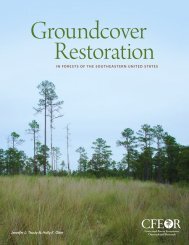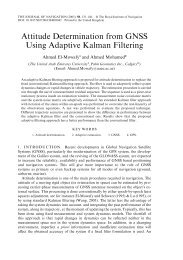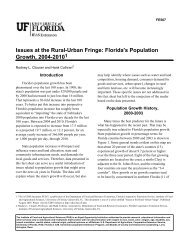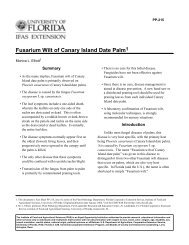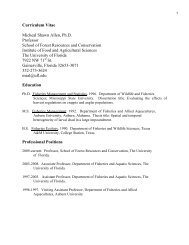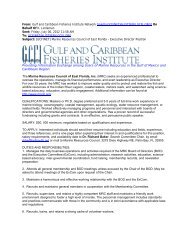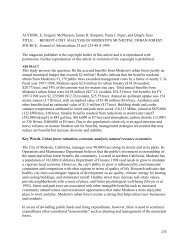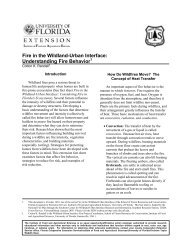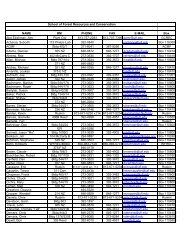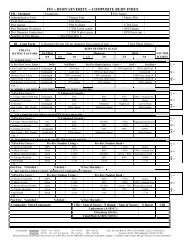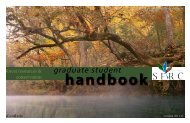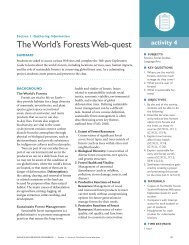Longleaf Pine Forest Restoration & Management - School of Forest ...
Longleaf Pine Forest Restoration & Management - School of Forest ...
Longleaf Pine Forest Restoration & Management - School of Forest ...
Create successful ePaper yourself
Turn your PDF publications into a flip-book with our unique Google optimized e-Paper software.
<strong>Forest</strong> Groundcover <strong>Restoration</strong> 2<br />
areas where the sources <strong>of</strong> degradation can be<br />
changed, restoration should begin only after these<br />
factors have been addressed. For example, in an area<br />
where bedding was used to change the water table to<br />
favor the growth <strong>of</strong> pine trees, many native<br />
groundcover plant species would not grow well due to<br />
the changes in water availability. <strong>Restoration</strong>ists<br />
would need to remove the bedding and restore the<br />
hydrology (the water cycle) before attempting to<br />
reintroduce the native groundcover.<br />
2. Define your goals and objectives in very<br />
specific terms.<br />
No single groundcover restoration plan would<br />
work at all sites. This is because restoration efforts<br />
must be tailored to address the unique problems that<br />
exist at each site. Before beginning to plan a timeline<br />
<strong>of</strong> activities for restoring groundcover, it is important<br />
to identify the target conditions you are aiming for.<br />
The goals <strong>of</strong> a restoration project should be broad<br />
statements <strong>of</strong> what you hope to achieve. For<br />
example, the restoration goal <strong>of</strong> your site may be to<br />
establish native groundcover species in an area that<br />
was converted to a pasture <strong>of</strong> nonnative grasses.<br />
Within this goal should be more specific objectives,<br />
which are more detailed statements describing the<br />
results you want to achieve. An example <strong>of</strong> an<br />
objective for restoring a pasture might include<br />
reducing the cover <strong>of</strong> non-native species to 10%<br />
within the next 5 years. By deciding in the beginning<br />
exactly what you are trying to achieve, you'll have a<br />
much clearer idea <strong>of</strong> when you've achieved it!<br />
3. Carefully consider how realistic your goals<br />
and objectives are.<br />
Finances should be one <strong>of</strong> your most important<br />
considerations when planning for groundcover<br />
restoration. It's important to realize that the costs <strong>of</strong><br />
the long-term maintenance may be more than the<br />
costs <strong>of</strong> the initial restoration activities. Many<br />
restoration efforts fail in the long run because not all<br />
expenses were included during planning.<br />
Before starting any restoration activities, ensure<br />
reliable, continuing access to funding, labor,<br />
equipment, and seeds or transplants <strong>of</strong> the species<br />
you want to reintroduce. If any <strong>of</strong> these resources are<br />
limited or uncertain, it is best to delay the start <strong>of</strong> the<br />
project.<br />
The costs that should be budgeted for a<br />
groundcover restoration project are:<br />
• Assessment <strong>of</strong> both the site to be restored and<br />
the reference sites (discussed below)<br />
• Purchase or rental <strong>of</strong> mechanical equipment<br />
• Mechanical preparation and maintenance <strong>of</strong> the<br />
site (disking, mowing, roller-chopping, etc.)<br />
• Chemical preparation and maintenance <strong>of</strong> the<br />
site (spraying herbicides)<br />
• Pyric preparation and maintenance <strong>of</strong> the site<br />
(prescribed burning)<br />
• Purchasing or growing plants and/or seeds to<br />
reintroduce to the site<br />
• Seeding and planting <strong>of</strong> desired groundcover<br />
• Monitoring<br />
If labor is limited, try contacting county<br />
agricultural extension agents, local plant societies,<br />
botanical gardens, high schools, and colleges. These<br />
organizations may have volunteers willing to donate<br />
their time and effort to assist with restoration.<br />
4. Identify the reference community for your<br />
site.<br />
The goal <strong>of</strong> most restoration projects is to restore<br />
the ecosystem that existed at that site before it was<br />
damaged. Unfortunately, a description <strong>of</strong> the<br />
conditions at the site to be restored is <strong>of</strong>ten<br />
unavailable. When historical descriptions cannot be<br />
found and there is no intact habitat on your site to<br />
compare to, you can use <strong>of</strong>f-site locations (known as<br />
"reference sites") as models. Carefully matched<br />
reference sites can help you define your restoration<br />
objectives by giving you a standard to imitate.<br />
Agency biologists or extension agents working in<br />
your area may be able to help you find a suitable<br />
reference site for your restoration project.<br />
5. Determine which restoration activities will<br />
be needed to reach the restoration goals you set for<br />
your site.



